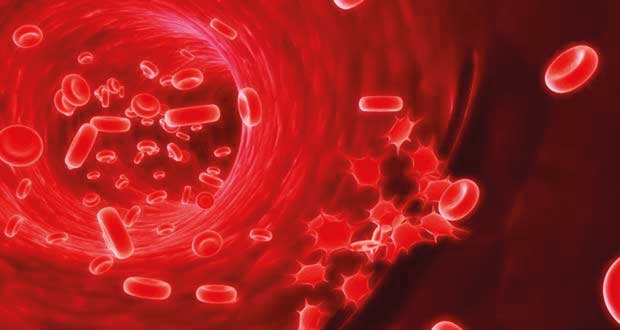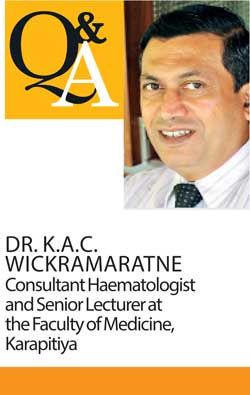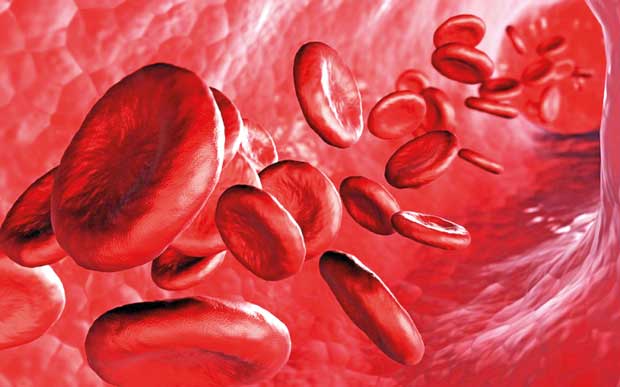09 Feb 2018 - {{hitsCtrl.values.hits}}

 Blood is an essential life sustaining component in our bodies. Recall the last time you experienced a cut or injury to your body. It would most likely have been a small wound. Remember how the blood initially discharged fast, then slowed down and stopped completely. All this happened during a short span of a few minutes. Our bodies have mechanisms to keep the blood from leaking out of the vessels. But there are certain conditions where this mechanism fails and even a small wound could be fatal. These conditions are called bleeding disorders. Today in Health Capsule, we present an interview done with Dr.K.A.C Wickramaratne, Consultant Haematologist and Senior Lecturer at the Faculty of Medicine, Karapitiya, during which he spoke at length when answering questions about bleeding disorders.
Blood is an essential life sustaining component in our bodies. Recall the last time you experienced a cut or injury to your body. It would most likely have been a small wound. Remember how the blood initially discharged fast, then slowed down and stopped completely. All this happened during a short span of a few minutes. Our bodies have mechanisms to keep the blood from leaking out of the vessels. But there are certain conditions where this mechanism fails and even a small wound could be fatal. These conditions are called bleeding disorders. Today in Health Capsule, we present an interview done with Dr.K.A.C Wickramaratne, Consultant Haematologist and Senior Lecturer at the Faculty of Medicine, Karapitiya, during which he spoke at length when answering questions about bleeding disorders.
Q What is Haemostasis?
In order to carry out its functions optimally, blood should be maintained as a fluid inside the vessel and should clot immediately if the vessel is damaged. If blood form solid ‘clots’ inside blood vessels, it may lead to death of the patient. In such instances death will come in the form of a heart attack or a brain attack. On the other hand, when a blood vessel is damaged bleeding has to stop immediately which happens as a result of the forming of a blood clot at the site of injury. If this doesn’t happen the person would bleed out. There should be a delicate balance between the two because a slight tip of balance either way could be fatal. This process is called haemostasis.

Q How does a wound stop bleeding following an injury?
Clotting of blood after a vessel is damaged is a complex process with the participation of multiple factors. To make a long story short, von Willebrand factor (vWF), a special protein in blood, binds to a protein called collagen in the damaged site. This makes way for platelets, the small disc like particles in the blood to come and bind at the site, which then attracts more platelets to the site. So, a blood clot is formed, blocking the leaking of blood.

To make the platelet plug solid and retainable, a crisscrossing meshwork of fibrin is formed as a result of a cascade activating a series of proteins in plasma, called coagulation proteins. This process, called coagulation, stops the bleeding completely, anchoring the platelet clump. The final process looks after the healing of the wound, which includes the gradual breakage of the anchoring meshwork that is replaced by vessel wall tissues.
Q What happens during a bleeding disorder?
A bleeding disorder is any problem in the factors or components required for the complete clot formation. That includes platelets, von Willebrand factor, collagen and all the coagulation factors.
These can have two problems; reduced concentration below the required levels and the defective function of the factor.
These diseases are commonly acquired due to diseases in the body. E.g.: platelets are reduced when dengue fever is present. Coagulation proteins reduce to levels below normal. This condition occurs during liver disease such as cirrhosis. When these components are not adequate or not working appropriately, people experience bleeding disorders. Some of these conditions are acquired in later life or may be coming from generations down as l (inherited) diseases. Low platelets can also be seen with blood cancers or related diseases. The platelet function can also be inhibited by drugs taken for heart attacks such as apirin, clopidogrel, dipyridamole etc.
Q How do these patients present?
The patients present with excessive and unusual bleeding, including heavy bleeding from a minor injury or during some instances spontaneous. They may complain of bleeding on the skin with no trauma or unusual blood stains in saliva, blood in urine, nose bleeds etc. Women can have heavy periods; a condition called menorrhagia.
When platelets or vWF is present in blood in very low amounts or if these are defective, bleeding occurs mainly into the skin and mucosa. Dot like bleeding patches, bleeding from gums, nasal bleeding, big patches of bleeding spots and profuse bleeding following trauma are common in these patients.

When coagulation factors are defective or less, bleeding usually occurs some time after. This type of bleeding is seen as bleeding into joints (haemarthrosis) or big bleeds into muscles (haematoma).
A typical story in many patients with this condition is heavy bleeding following a tooth extraction. If the bleeding is immediate it is most likely due to a problem in platelets or vWF. If there was no bleeding issue after extraction and if the patient starts bleeding some times later, this is usually a problem in coagulation factors.
Q What are the common bleeding disorders seen today?
Von Willebrand Disease
This is the commonest out of all the bleeding disorders, with one in hundred individuals having the disease. It is inherited and may go unnoticed as ‘something normal’ in the family; specially among females. For instance the women in these families tend to have heavier menstrual periods than normal.
Haemophilia
This is a very rare disease, with only around 2000 patients being present in all of Sri Lanka. Haemophilia occurs due to a deficiency of some coagulation factors. Commonly it is the deficiency of factor VIII or IX (different factors are named with roman letters). This disease is transmitted from genes; ex: mother to son. Females generally do not have main disease. Therefore, maternal uncles with bleeding problem could be indicative of haemophilia. These patients can present at toddler age, with bleeding into joints when trying to stand.
Q How do you treat patients with bleeding disorders?
Patient education on various bleeding patterns is vital during treatment.
Coagulation defects such as haemophilia can be treated by giving periodic injections. Nowadays patients are trained to receive injections at home. In main hospitals haematologists have established haemophilia day centres to provide better care for such patients. These patients should be advised to avoid contact sports and to keep away from risky behaviours.
Platelet problems demand proper identification of the underlying disease. Steroids may be prescribed during some immune diseases.
They should not take Aspririn or related drugs without proper consultation of a doctor due to the risk of bleeding. They should always alert the doctor about their condition whenever they seek medical care.
23 Dec 2024 22 minute ago
23 Dec 2024 53 minute ago
23 Dec 2024 59 minute ago
23 Dec 2024 1 hours ago
23 Dec 2024 2 hours ago